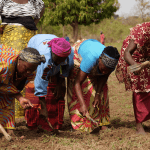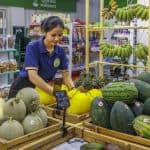Field of View: How a Chilli Cash Crop Helps Subsistence Farmers Shape Their Future
When she sat down across from me, an old door laid flat on top of two stumps functioning as the makeshift table between us, I immediately felt like something had expanded, that the possibilities were different – simply, that the world had just become a bigger place. People who have worked in the sun their entire lives, no matter what part of the world they’re in, seem to marry old age and youth simultaneously. Their skin always makes them look older than they are, but their eyes have captured a sparkle from all the light that reflects a youth that may be long past them. Pumsa was no exception. A woman in her late forties, already a grandmother multiple times over, she walked and sat like a women 20 years her senior. Yet the eyes of this lifetime subsistence farmer pulled her back into her early thirties every time she smiled.
Our conversation was part of a three-year process my colleagues and I have been conducting, to assess the impact of growing a chilli cash crop on small farmers living in southern Africa. Our client, a global restaurant chain, has built its brand around a particular variety of chilli. It determined that controlling the growth of this chilli was critical not only to secure its supply, but also to manage its brand identity. Historically, it has provided various food processors with the specifications of the chilli it wants, along with other ingredients. It receives “spice mixes” in return, which are used directly in its kitchens or converted into the various sauces it uses. As this chilli is a core ingredient in almost every recipe, securing its supply and understanding its provenance are critical to both the chain’s brand and expansion requirements.
Chilli, therefore, offered a unique opportunity to test direct ingredient production and understand how its supply chain could promote both its values system and make a positive social contribution. All these interests aligned through the creation of a small farmer supply chain based in southern Africa.
Reducing poverty levels
The belief when we started was that introducing a chilli cash crop would meaningfully reduce the levels of poverty among the participating farmers. This assumption was based on the premise that most of the farmers who would be participating live off the crops they grow, which they sell at local markets or eat. However, crop prices could not be determined before growing decisions were made, nor could local markets be relied upon to sell the produce farmers grew. Moreover, these farmers generally lacked the high-quality seeds, fertiliser, herbicides and water to increase yields and produce at a larger scale. Additionally, since alternative means of income generation were scarce and unemployment high, these farmers could not afford basic human needs such as health care, education or food security.
Based on these assumptions, a theory of change was developed with two core components:
- Introducing a chilli cash crop into these communities – with a minimum growing area of .25 hectares (approximately .6 acres), guaranteed prices and a commitment to buy everything produced, as well as providing credit for farming inputs and technical assistance – would generate significantly higher incomes and allow these families to access a range of basic human needs otherwise inaccessible; and
- Introducing a chilli cash crop into subsistence farming families would not have any negative impact on food security, in particular the loss of crops grown for eating, or other social dynamics.
To test this theory, a baseline assessment was conducted in every community where chilli was going to be grown, to gauge what was “normal” regarding housing, energy, water, effluent, health care, education and food security – or their basic human needs. Then, after each season, an impact assessment was conducted to determine how much net income was earned, how much of their time was required to create that income, how the extra money earned from chilli was spent, and whether it actually made any difference in relation to their needs.
What changed in farmers’ lives?
The methods used for both of these assessments were personal interviews conducted with farmers, nurses and doctors at local clinics/hospitals, teachers at schools, community leaders, in addition to personal observations of the communities they lived in. From this process, we assessed “impact” using both numerical scores and personal stories. This provided us the privilege of having hundreds of intimate conversations with small farmers, in multiple countries, over multiple seasons, to understand how they live, what is important to them and what if anything changed in their lives from growing a single cash crop.
What we have found has been fascinating. These communities are characterised by income levels of less than $2 per day, schools that are relatively far away with classrooms of 50-200 children on average, and a local clinic which is accessible but does not have a doctor. Doctors can typically be found only at hospitals that are 10-100 kilometers away, and there are never more than two on duty at any time in facilities that house 200-plus people. Houses are generally made from either handmade bricks or reeds. Water is usually from a community well 100 meters to 2 kilometers away, is carried in 20-litre buckets by women and children, and is not always available and rarely tested for quality. Most people use wood for cooking and candles or paraffin for lighting and batteries to charge cell phones.
Within these circumstances, it is not surprising that virtually all the money earned is used to address one or more of the farmers’ basic human needs. It is not spent frivolously, ever. Additionally, we discovered that there are different prevailing value systems that influence how people allocate their scarce resources. For example, in Zimbabwe, education is almost always prioritised. Most things will be sacrificed to achieve a better education for their children. In Malawi and Mozambique, the first priority is generally housing or home upgrades – a solid roof, new room, additional pit latrine or solar power.
One of the most surprising findings, however, was that when a family earned just $500 more of net income per annum, this money materially impacted at least two categories of their basic human needs. Like buying a donkey cart to move materials and crops, fetch water and charge for lifts. This one cart meant going to the well one time instead of 10, getting crops to markets previously inaccessible, and greater efficiency in the planting and harvesting process. Or the ability to purchase animals to bank for food security, raise for sale or simply to keep as an appreciating asset. Or pay overdue school fees and buy uniforms and books, which might have been preventing children from attending school. This relatively small amount of money moved these farmers from earning less than $2 a day to $4, which materially matters. Additionally, we found that growing this cash crop did not compromise their food security nor create any other negative unintended consequences.
But the most profound impact I had yet to witness, before talking to Pumsa, was that of self-determination.
Giving a measure of certainty
Small farmers live in a world full of uncertainty. They cannot control the weather that will define their yields, where the markets for their produce are located nor the price they will be paid for their crops. Without the option of formal employment, their income is mainly outside of their control. This makes aspirations for the future generally nothing more than hopes and dreams disconnected from their own determination and capacity to realise them.
One impact explored in the farmer interviews is: How did you spend the extra money earned from growing chilli, and was this how you planned to spend it before the season started? The answers to these questions generally reflect someone who does not have financial expectations and is unable to link their desires and reality. The answer in previous assessments was, “I didn’t know what I would earn so had no plans for spending it” or “I thought I would spend it on x but, actually spent it on y.”
After growing chilli for three years, what had changed for Pumsa was that she had identified specific things she planned to spend the money on before the season started – two additional rooms in her house, sending her child to university, and baby chicks for a new poultry business. She set goals, she planned and she spent the money in the main the way she intended eight-12 months in advance of earning it. This psychological shift from someone who only responds to the world into someone who shapes it, is nothing short of extraordinary. Her experience was not unique; the vast majority of farmers who had been growing chilli for three years all planned before the season started and then realised those plans based on their own hard work.
The impact this chilli crop has had on food security, access to education, energy, housing and health care cannot be minimised, but it seems the experience of manifesting your own destiny has enabled a power which could not have been predicted, nor do we fully understand its implications. Although the ethical supply chain and impact measurement sectors have gotten a lot more sophisticated over the past five years, we have not developed the tools nor found the language to document and measure this kind of change. Understanding more about the repercussions of this kind of impact offers exciting new frontiers for the sector but, more importantly, it offers new opportunities to connect consumers more deeply to the humanity of their consumption.
Tanner Methvin is a partner in Impact Amplifier and Earth Capital.
- Categories
- Agriculture



